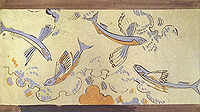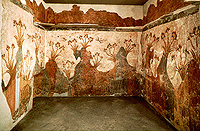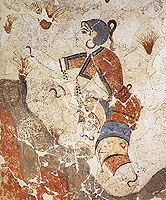

The art of fresco is certified in the Aegean islands from the beginning of the Late Bronze Age. The earliest signs come from the settlement of Phylakopi. It is a marine representation with flying fish which dates to the Late Cycladic I period. But the principle and most rich source of Late Cycladic wall paintings are the frescoes at Akrotiri of Thera. These frescoes come from the upper floors of the settlement buildings where obviously the most important rooms were. Sometimes the interior of the rooms was completely covered with frescoes the themes of which were integrated in a predetermined iconographic scheme. The so-called miniature frescoes were extensive representations of small-sized figures which were painted at the height of the eye. The Theran wall paintings were made with the fresco technique, that is to say painting on damp lime plaster. In some parts the aquarelle technique was employed, this being applied when the wall was already dry. The paints derived from plants and mineral materials and the colours were restricted to white, black, red, blue and yellow, as the Minoan ones. The style and themes of the Theran frescoes indicate that their models must be sought in the frescoes of the Minoan palaces and the villas of the Neopalatial period. Among the Minoan elements, decorative motifs known from the Mycenaean frescoes and mainland Greece metalworking are distinguished. These elements may not represent Mycenaean influence in the Cyclades but may be local Cycladic elements which were imported in the painting of the Greek mainland. In contradiction to the Minoan frescoes, most of which are known from disputed restorations, the wall paintings of Thera are in a very good state of preservation. Thus, apart from their great artistic value they offer valuable information of the everyday life in the beginning of the Late Cycladic period. The themes include different cycles: isolated human figures, still life, marine landscapes and landscapes with profuse vegetation. The representations are framed by abstract decorative themes. The religious scenes prevail among the fresco themes. The worship postures of human figures and the accompaniment of religious symbols indicate that the frescoes depict frequently members of the priesthood, deities and persons that participated in sacred rituals. The frequent repetition of the religious themes also reveals that many of the areas of Akrotiri were used as sanctuaries. Apart from the religious scenes, human figures appear in scenes of a secular character as well. In the miniature fresco or "Flotilla miniature frieze" , as it is also named, from the West House, the arrival of a fleet to a coastal town and scenes of a naval battle are depicted. This representation -which is of a narrative character- appear to imply a historical event or a legendary narration. The rich frescoes of Thera do not constitute a unique phenomenon in the insular art. Parts of frescoes found at Agia Irini on Keos and some new finds from Phylakopi show that the frescoes were probably a common way of decorating internal areas. |
 |
|
|
Melos, Phylakopi II. Drawing restoration
of part of a fresco with flying fish. Late Cycladic I period. |
||
 |
||
|
Thera, Akrotiri-Sector Delta.
The "Springtime Fresco". |
||
 |
||
|
Thera, Akrotiri-Xeste 3. Detail of the
fresco of the Saffron Gatherers. |
||